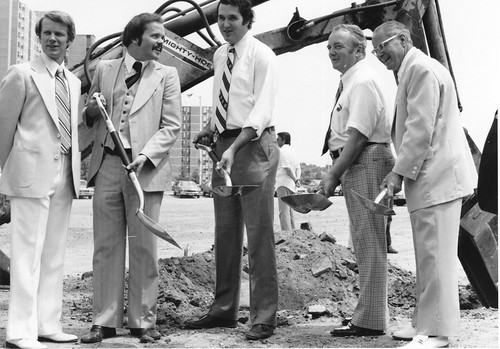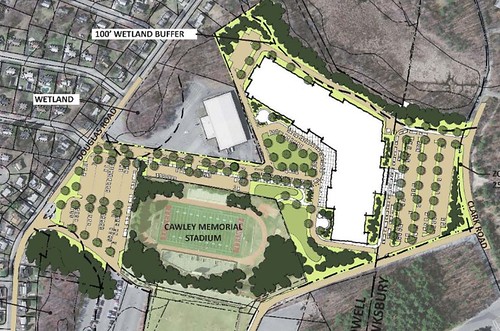Lowell Week in Review: February 5, 2017

Groundbreaking for LHS 1980 building. School committee members William Kirwin, Gerald Durkin, Robert Wolfgang, Clement McDonough and Daniel Kane
Lowell High School
The New Lowell High School project continues to dominate local news. Tuesday night, the architects will do a presentation for the city council on various “conceptual options” with “very preliminary” cost estimates for each. The presentation slides are in the city council packet in case you want an early look at them. Here are some highlights, showing the total cost of several options and the amount of that cost that will have to be paid for by the city because it does not qualify for state reimbursement:

LHS 1980 building under construction
Full renovation of existing high school: $331mil (city share $116mil)
Renovate existing LHS, replace fieldhouse, add new freshman wing: $344mil ($135mil city share)
Entirely new LHS in Pawtucketville – $325mil (city share $142mil)
Entirely new LHS at Cawley Stadium – $332mil (city share $148mil)
(There are five or six other options for the existing site, all within about 10% of the above estimate).

Footprint of Cawley site (new buildings in white)
Some observations: The cost of the various options don’t vary all that much, certainly not enough to tip the decision one way or another. That means other factors such as the amount and length of disruption willing to be tolerated during construction and the potential long term impact on downtown, Belvidere, or Pawtucketville by having a new high school in the neighborhood, should drive the decision. Of course, one option is to do nothing because of financial considerations, such as, a lot of property owners in Lowell don’t want their taxes to increase for any reason.
Over the past two weeks, there’s been a lot of buzz in favor of the Cawley Stadium option, led mostly by an interesting coalition of parents of kids who would be attending the high school during construction; the anywhere-but-downtown crowd; sports enthusiasts who believe co-locating the school and the athletic fields will restore LHS to athletic prominence; and a sprinkling of those who don’t care about the high school but have a kind of stick-it-to-Belvidere approach. Certainly the closeness of the price estimates between the new school at Cawley option and the various downtown options (about $330mil) should encourage Cawley advocates (although the city’s contribution would be $32mil greater at Cawley).
But there’s also a big pushback coming from Belvidere residents who don’t like the idea of 3000 students and 400 staff and all their associated vehicles driving to and from their neighborhood each day. Given the high turnout rate of Belvidere residents in city elections, any kind of organized, anti-Cawley resistance would be very persuasive to councilors.
The upcoming Belvidere Neighborhood Association meeting this Wednesday at 6:30 pm at the Sullivan School will be an opportunity to gauge the relative strength of the pro- and anti-Cawley groups. More importantly, it will give councilors some feedback on this issue from residents. (Additionally, Rita Mercier has a motion on Tuesday’s council agenda asking the city to schedule a public meeting about the high school so councilors will have an opportunity to hear from constituents).
At last week’s council meeting, a response to an earlier motion inquiring about the process of a non-binding referendum was presented. It’s pretty simple. You just need a few tax payer signatures and an affirmative vote of the city council. At first, I thought the referendum route was irrelevant because the tight timetable imposed by the state on this process required a decision much sooner than November, but I was wrong about that. City Manager Murphy explained that the tight timetable is to minimize construction costs – the longer it takes to get the project underway, the more it will cost. But he clearly said that if the council wanted to delay its final decision until after a November referendum, the project would not be jeopardized.
I think councilors will find the referendum option very attractive. Not only will they be able to say their vote was guided by the will of the people (or at least those who vote in the city election), but it will also put off a controversial vote until after the council election. Voting any time from now until the election puts councilors into an electoral bind, because whichever way they vote, they will make someone upset and less likely to vote for them.
Still, the referendum route could have some unintended consequences. Making a new Lowell High School the central issue in a city election could draw more candidates and voters with destabilizing results to the political status quo. Plus, there will be great pressure to put off the decision to January to let the new council decide. So perhaps there will be no referendum after all.
Lowell Waterways Vitality Action Plan
Congratulations to Fred Faust and Paul Marion for all of their efforts on the Lowell Waterways Vitality plan which will use modern lighting to draw attention and people to several water features in Lowell to spur economic development and increase local pride and satisfaction with our city. The two minute video that brings this vision to life already has 37,000 views and 744 shares on Facebook.
The sites to be illuminated are the Swamp Locks in the midst of the Hamilton Canal Innovation District; the Lower Locks alongside the UMass Lowell Inn & Conference Center; the Merrimack Canal at Lucy Larcom Park; and Ecumenical Plaza which connects Holy Trinity and St. Patrick’s churches in the Acre. Also to be illuminated are the Cox Bridge on Bridge Street and the Ouellette Bridge on Aiken Street.
For more details about this effort, see my report from Thursday night’s meeting. To see the video and to learn more about future plans, check out the Lowell Heritage Partnership website.
Lowell Trust Act
A group of Lowell residents will present a petition to the council at Tuesday night’s meeting asking councilors to consider adopting a Trust Ordinance of the type previously enacted by Boston and other cities in the Commonwealth. The Boston Trust Ordinance provides guidance to local law enforcement on how to handle requests from federal immigration officials to detain certain individuals in city custody.
From a local law enforcement perspective, this type of ordinance is a good idea. Like poor people everywhere, recent immigrants and refugees are the members of our community most likely to be victims of crimes. As such, they are the ones most likely to come into contact with local law enforcement as crime victims and witnesses. Yet if they are fearful of the immigration consequences of such cooperation, they won’t do it and crime will go undetected and unpunished.
This will unfortunately be a controversial measure. Much effort has been expended to demonize immigrants and refugees, so too many in our community will have a reflexively negative response to this. But this is not something the council should sidestep with claims it’s a federal issue. It’s not. The people affected live here in our midst. This needs to be addressed.
The petitioners ask the councilors to refer the matter to a subcommittee for further investigation and discussion. That seems like a wise course that hopefully will be followed.
Local Media Departures
Best wishes to the Lowell Sun’s Grant Welker and Lisa Redmond as they move on to new employment opportunities. Welker heads to the Worcester Business Journal; Redmond is going to Patch.com to be the online news site’s Middlesex County court reporter. Patch was started a number of years ago be America Online and has thousands of local sites around the country including ones covering Chelmsford, Tewksbury, Westford, Andover and Bedford. The local sites are supplemented by centralized regional coverage of the type Lisa will provide.
If the HS is going to be located on West Meadow Rd. They better be building two new bridges over the river to accommodate the additional traffic. Most morning traffic is backed up from the river to the